ArcUser
Fall 2012 Edition
Opening Our World
This article as a PDF.
"GIS today is at a major turning point because it is now capable of broadening its reach, enabling pervasive adoption," said Jack Dangermond, president of Esri, as he welcomed nearly 15,000 attendees from more than 130 countries to the Plenary Session of the Esri International User Conference (Esri UC) held July 23–27, 2012 in San Diego, California.
"Geography is our platform for understanding the world," said Dangermond, underlining the conference theme, GIS—Opening Our World. He observed that GIS makes geography come alive by condensing data, information, and our knowledge into a kind of language that can be easily understood. "It's a language that is increasingly recognized as a powerful means for reducing complexity and quickly understanding the dimensions of a situation."
Dangermond observed that this year marks the 50-year anniversary of GIS. The technology has advanced rapidly during these decades, allowing many geographic processes to be abstracted and modeled as well as creating maps and records that accurately portray the world and how it is changing. The adoption of GIS by hundreds of thousands of organizations has improved planning and management and led to greater efficiencies. In its next phase, GIS is being applied to the design of a better future through evaluating scenarios, involving citizens through crowdsourcing, and assessing the impact of human activities at different scales.
"Yet, the greatest achievement of GIS is yet to come: the widespread understanding and application of geographic knowledge by everyone," said Dangermond. "The emergence of GIS in the cloud, together with new concepts for web enabling geographic knowledge, provide promising possibilities for accessing and leveraging the work of GIS professionals around the world."

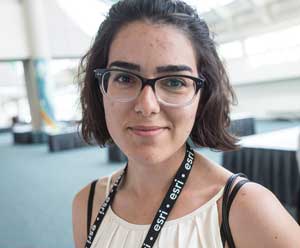
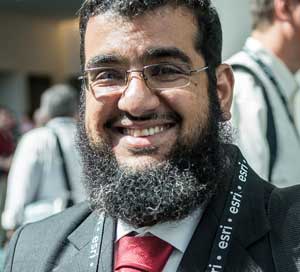
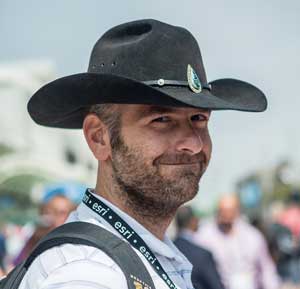
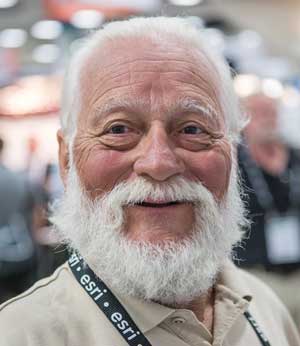
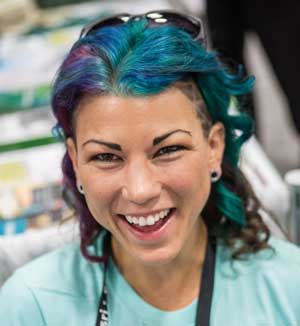
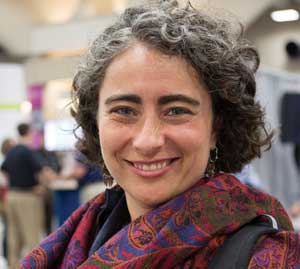
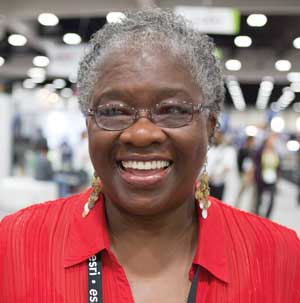
This new paradigm amplifies the work done on the desktop and server by disseminating geographic knowledge through an online platform that can make it available everywhere to anyone via pervasive mobile devices. That online platform is ArcGIS Online. In another Plenary Session presentation, Bern Szukalski, Esri product strategist and technical evangelist, remarked that ArcGIS Online has evolved from the simple framework for sharing data introduced four years ago into a cloud component tightly integrated with the ArcGIS system. ArcGIS Online content has grown rapidly as a result of user contributions and the substantial investment of resources by Esri—building basemaps, integrating available data, and purchasing commercial data.
However, Szukalski said the biggest impact of ArcGIS Online is that it has transformed "the way that we think about and the way that we use GIS." Szukalski introduced members of the Utah Department of Transportation (UDOT) who have used ArcGIS Online to transform their organization. UDOT's GIS manager Frank Pisani explained how the ability to rapidly publish web content has extended the value and capability of UDOT's GIS and changed the way people think about maps. Instead of handling map requests with static PDFs, users now expect a link to a live, dynamic web map.
With a simple web application template, the end-user functionality of GIS is now in the hands of nonusers, and everyone now has access to the information.
"Oftentimes when someone asks you for a map, they're not asking just for a map," said Szukalski. "They're asking for a way to convey answers to certain questions."
A Glimpse into the Future
Each year, during the Plenary Session, attendees are introduced to future leaders and innovators in the GIS industry through presentations made by high school students enrolled in GIS classes. This year, students from Washington-Lee High School in Arlington, Virginia, presented their senior projects. Students applied GIS to real-world problems that ranged from storm water contamination to analyzing the impact of a proposed metro station. Washington-Lee is one of 16 schools participating in the Geo-Spatial Semester program sponsored by James Madison University in Virginia in the past three years.
Awards for Excellence
In addition to sharing Esri's plans for the development of GIS technology, the Plenary Session was an occasion for reflecting on achievements of Esri users and presenting awards. The first of these awards was the Esri President's Award. Its recipient, the US Environmental Protection Agency (EPA), has been using Esri GIS products for more than 25 years to support environmental decision making. The agency's most recent project for integrating science with public policy is GeoPlatform. EPA uses GIS as a platform that incorporates a private GIS subscription service for accessing data and building web applications, a private cloud for sharing data internally that uses role-based security, and data and application services built on its GIS server infrastructure that feeds the public and private clouds. Malcolm Jackson, EPA assistant administrator and CIO, received the award from Dangermond.
The Esri Making a Difference Award is given to organizations that have used GIS to bring about meaningful change in the world. This year, two organizations received the award. The first, the Trust for Public Land, has been helping create more livable cities by conserving more than three million acres of open space and developed recreation over the last 40 years. Breece Robertson, the trust's director of conservation vision, and Will Rogers, chief executive officer, accepted the award.
The City of Honolulu received the second Esri Making a Difference Award for a rail transportation project that employed geodesign techniques and the 3D visualization tools in CityEngine. When accepting the award, Honololu mayor Peter Carlisle remarked that the city famously has the worst traffic in the United States, coupled with ever-increasing urban sprawl that threatens the city's sustainability. Ken Schmidt, Honolulu's GIS administrator, and Michael Contreras of Esri demonstrated how GIS was used to show residents the efficiencies that would result from the elevated rail line and spread of urban sprawl if action is not taken.
"Of course, having all this great GIS content and knowledge means nothing if we can't share it, especially given that we need the public backing to make the elevated rail transit line happen," said Carlisle. Quickly generating 3D representations that use photos of actual buildings and the ability to interactively explore design options at public meetings has helped enlist public support. Carlisle expressed his belief that transportation oriented development "will provide the spinal column for sustainable transportation, long-term job growth, a greener future, and smart land use that will last for a century to come."
"So Geodesign Has Taken Over My Life"
Stephen Ervin, a Harvard University professor and geospatial science visionary who has been instrumental in the development of geodesign, received the Esri Lifetime Achievement Award. "Geodesign fuses imaginative and functional creativity in environmental design and planning with analytic geospatial science. It is thinking about systems and realizing that transportation planning affects agriculture planning," said Ervin during his acceptance speech. "And so, geodesign is just in time, as I've said, powerful enough to help make the planet better for the maybe 10 billion people who will be here by the end of the century—not just cities and dams and housing developments and transit systems, but systems for people."
SAG Awards
As in previous years, Esri recognized organizations from around the world for innovative and intelligent applications of GIS technology with Special Achievement in GIS (SAG) Awards. "Each year, the SAG Awards highlight extraordinary achievements and efforts to improve our world," said Dangermond at a special ceremony on July 25 honoring the 170 recipients. Get more information about the 2012 SAG Award winners.
Keynote Address
"With each species' extinction, the beauty of our planet diminishes," said Julia Marton-Lefèvre, director-general of the International Union for Conservation (IUCN), in her Keynote Address to conference attendees, which concluded the Plenary Session. IUCN is the world's largest global environmental network, and its Red List of Threatened Species is considered the most comprehensive and authoritative resource for threatened species information. The list is compiled by thousands of volunteers, and GIS has become an important technology for locating species and preserving their habitats. During her address, Marton-Lefèvre announced the launch of the Red List of Endangered Species map viewer, built on ArcGIS 10.1, which enables people to access species information to improve planning decisions.
A Busy Week
The three days following the Plenary Session were packed with paper presentations, technical workshops, special interest group meetings, and social events. The information and contacts were valuable to veterans as well as first-time attendees like Barry Conner.
"My first Esri conference exceeded my expectations more than I could have imagined," said the GIS analyst from the City of Huntsville, Texas. "Though I came with many years of GIS experience in my area of specialization, I very quickly learned of methods and resources which will totally revolutionize the way I work. I can hardly wait to implement the things I've learned. Beyond the knowledge, I met many helpful and brilliant people who have shared generously of their time and expertise."
For others, the conference reinvigorates their passion for the technology. "The Esri User Conference is the most valuable week of my year. The technical workshops are excellent and the opportunities to meet others and exchange ideas are unsurpassed. I get energized each year by attending the conference," said Kevin Sato, GIS/IT services manager for Cottonwood Heights, Utah.
Developer Events
Developers at the 2012 Esri UC attended special events designed specifically for them: the UX Design Summit, a Dev Meet Up, and the Hackers' Sandbox. At the UX Design Summit on July 24, design industry professionals from Esri, Seso, and the California College of the Arts communicated their holistic approach to designing great applications through presentations and Lightning Talks. They discussed design rationale, implementation procedures, and strategies for building great user experiences.
At the Dev Meet Up on July 25, Dave Bouwman, CTO of Data Transfer Solutions, gave the featured keynote presentation. Developers demonstrated web and mobile applications and discussed ideas for their development.
Hackers' Sandbox, held July 24–26, was a place for developers to meet, network, demonstrate projects, and share ideas using machines provided by Esri to test-drive ArcGIS technology in group or self-paced activities.
Ancillary Events
GIS legend Roger Tomlinson kicked off this year's unconference for GIS managers on July 24. Held concurrently with the Esri UC, this unstructured event, now in its third year, gave GIS managers, business and technology strategists, and other decision makers a chance to discuss whatever topics they deemed important.
The 2012 Education GIS Conference, held July 21–24, 2012, drew a record number of educators, librarians, and others involved in GIS education. (See the accompanying article, "Entering a New Era in GIS Education.")
The 2012 Esri Business Summit, another concurrent event, brought together business leaders interested in place-based decision making that improves customer service and profit margins. (See the article "Keeping Service Levels High and Costs Low.")
Reviewing 2012 and Looking Forward
Esri UC plenary talk videos and technical session podcasts are available at esri.com/uc for those who missed this year's conference. The next Esri International User Conference will be held at the San Diego Convention Center, San Diego, California, July 8–12, 2013. In the words of 2012 attendee Robert Largent, an environmental specialist for the Cherokee Nation, "The Esri User Conference is the one-stop shop learning experience every GIS professional should mark on their calendar."